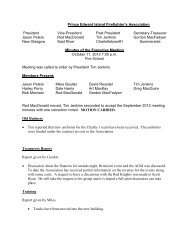volunteer firefighter recruitment and retention strategy
volunteer firefighter recruitment and retention strategy
volunteer firefighter recruitment and retention strategy
You also want an ePaper? Increase the reach of your titles
YUMPU automatically turns print PDFs into web optimized ePapers that Google loves.
Immigrant PopulationsResearch into engaging immigrant populations in communities through <strong>volunteer</strong>ism hasshown that the main reason immigrants <strong>volunteer</strong> is to give back to the community (CanadaSurvey of Giving, Volunteering, <strong>and</strong> Participating (“CSGVP”) 2007). Volunteer firefightingcan be communicated to immigrants as an important service that improves communitysafety <strong>and</strong> cohesiveness. Similar to communications to local business owners, <strong>volunteer</strong>firefighting can be positioned to immigrants as a way to give back to the community.Immigrants are more likely to list barriers to <strong>volunteer</strong>ing than native-born Canadians. Oneof the top reasons immigrants do not <strong>volunteer</strong> is that they do not know how to becomeinvolved (CSGVP). It is recommended that <strong>volunteer</strong> fire departments examine thedemographics of their community <strong>and</strong> adjust <strong>recruitment</strong> efforts accordingly. One tactic citedas successful by fire departments is to first focus efforts on engaging a few members of alocal immigrant population; others are then more likely to follow. Immigrant populations arelikely to <strong>volunteer</strong> at religious organizations (CSGVP). This may be an effective venue forappealing to these populations through advertising, personal <strong>recruitment</strong>, or speakingengagements.One special concern with engaging immigrant <strong>volunteer</strong>s as <strong>firefighter</strong>s is that their Englishlanguageskills must be very good. They must be able to underst<strong>and</strong> what is being said <strong>and</strong>speak quickly when responding to a fire. Please see the tool Volunteer Firefighter ScreeningProcess Guide for screening practises related to this particular barrier. In the event that anapplicant‟s English skills are not sufficient, the immigrant may still be engaged in the firedepartment as an administrative <strong>volunteer</strong>. This would give the applicant an opportunity toimprove their English skills, perhaps even to the level where they can apply to be a<strong>volunteer</strong> <strong>firefighter</strong>.First Nations PopulationsFire departments located on First Nations face several challenges in addition to those facedby fire departments on non-settlement l<strong>and</strong>. In meeting with Leon Smallboy (Fire SafetyCoordinator at First Nations (Alberta) Technical Services Advisory Group), it was noted thatsome of the issues affecting the <strong>recruitment</strong> <strong>and</strong> <strong>retention</strong> of <strong>firefighter</strong>s faced by FirstNations fire departments are:Inadequate funding – First Nations fire departments are provided a set amount offunding dollars based on formulas established by Indian Northern Affairs Canada,some of which have not changed since 1990. Funding affects the ability to providecompensation for responding to fire calls.First Nations may not see their fire departments as a priority because of other issuesaffecting their community (including issues related to water, the environment, roads,<strong>and</strong> social issues);Other issues (such as youth engagement) related to cultural nuances.Volunteer Firefighter Recruitment <strong>and</strong> Retention Strategy & ToolkitPrepared by Volunteer Alberta for the Alberta Fire Chiefs’Association6





